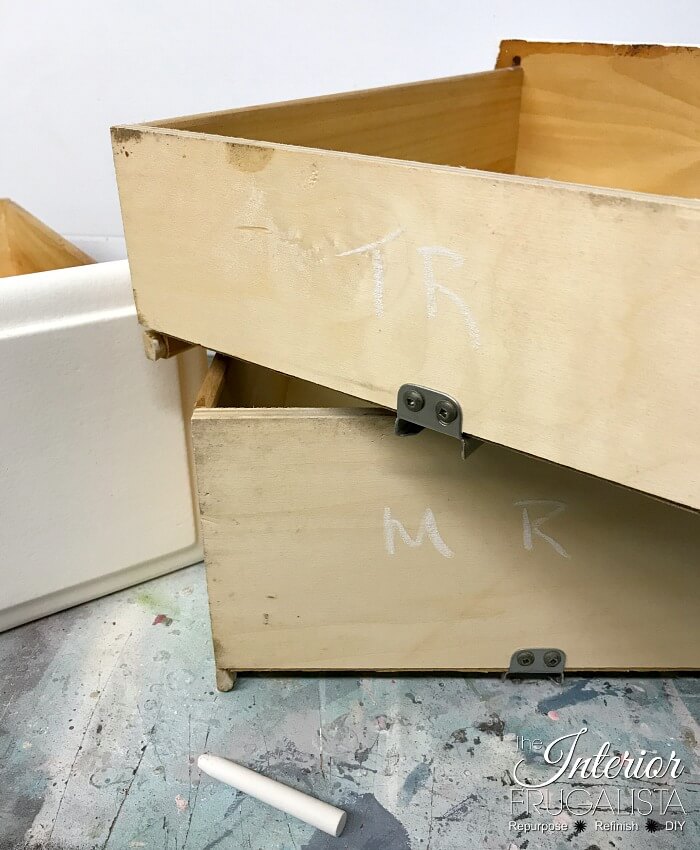How To Prep Furniture For Chalk Paint A-Z
Should you sand furniture before painting it with chalk paint? This is the one question I get asked most often and my answer is, it depends. While many chalk paint brands say their paint doesn't require sanding, I always err on the side of caution, especially considering I sell my pieces.
Having said that, there are some instances where I absolutely won't sand. So today I'm finally sharing helpful tips on how to prep furniture for chalk paint from A to Z. I hope you find them helpful and it answers any questions you may have.
Helpful Tips On How To Prepare Furniture For Chalk Paint
Whether you are about to paint your first piece of furniture or have a few pieces under your belt, I hope you learn something new in this tutorial.
I have a workshop in the basement of our home. I also live in the Canadian prairies where our winters are long so good ventiliation is always a challenge.
For these reasons, I try to always use low to no VOC (volatile organic compound) products. Hence the reason why chalk-style paint is my preference for painting furniture.
I've included links to my go-to makeover products throughout this tutorial. They contain affiliate links and as an Amazon Associate, I earn a small commission from qualifying purchases at no extra cost to you.
Before we get into the nitty-gritty of the furniture painting tutorial, almost all of the DIY projects shared here at Interior Frugalista have step-by-step tutorials so why not get your budget DIY on and subscribe. You can also follow us on Pinterest, Facebook, Instagram, and YouTube.
We'll start from the very beginning, cleaning your new found treasure.
Tip 1 - Cleaning The Furniture
Vacuum all the cobwebs inside, underneath, and on the back. Wipe down all the surfaces with a damp rag. My preference for cleaning furniture is 1 part white vinegar to two parts warm water with a drop of dawn dish soap.
Tip 2 - Remove The Drawers And Doors
Some people prefer to keep the doors and drawers in place when painting furniture. Unless the piece is really old and there is a chance of not getting the hardware lined up again, I always remove them. This way it is easier to paint the frame around the drawers.
But before you remove them, always label the back of each drawer with chalk or painter's tape so you know which belongs where. Trust me, those drawers may all look the same size but oftentimes they don't go back in the same way.
Tip 3 - Remove The Hardware
Unless you plan on painting the original hardware (which I've been known to do on occasion), remove the knobs, pulls, and hinges. Place them in a tray or small container so they don't get lost.
Tip 4 - Raise The Furniture Off The Ground
Raise the furniture off the ground so it's easier to paint along the bottom. My preference is these 3-wheel furniture dollies which allow you to easily move the furniture around as you work. Another stationary option is raising it onto blocks of wood or paint cans.
If you suffer from back or knee pain like I do, a hydraulic rolling mechanic stool will be your best friend. Raise and lower it as needed and scoot around the furniture as you work. No more constantly getting up and down or kneeling on a hard floor.
Pro-Tip
You'll want a stool with a stem that doesn't restrict how far it can be lowered.
Tip 5 - Fill Any Scratches, Dents, And Imperfections
Fill any holes, deep scratches, and dents with a non-shrinking filler compound.
Tip 6 - Do NOT Sand Furniture If:
- You suspect it may have been painted with lead paint. Painted pieces from the late 70s and back are more likely to contain lead. There are lead test kits available should you want to test first. I personally err on the side of caution unless I'm 100% certain.
- It has a smooth Arborite or high gloss enamel finish.
- The wood is red oak, walnut, cherry, or mahogany. Sanding will open the grain and cause the tannins in the wood to bleed through the paint, especially if you plan on painting a light color.
Tip 7 - How To Prep Furniture That CAN'T Be Sanded
For smooth Arborite or high gloss enamel surfaces, always prime first with either a brush or foam roller. My go-to primers are Zinsser Bulls Eye 123 Primer or Slick Stick.
To hide stubborn stains or wood-prone to cause paint bleed, use a stain-blocking primer like Zinsser Stain Blocking Primer Plus or BOSS, especially if you're painting a light color or white. If pink or brown stains appear after the first coat of paint, apply another coat of primer in those areas.
Tip 8 - How To Prep Furniture That CAN Be Sanded
You'll notice the photos included in this post is of a previously painted piece. I knew it was safe to sand because I was the one who painted it many years ago with latex paint.
Wrap 150-grit sandpaper around a sanding pad and lightly sand to give the paint some bite.
You may need to bring out the big guns and sand with either an orbital sander, palm sander, or mouse sander.
My preference is a mouse sander because I like how it feels in my hands, it can easily get into tight corners, and I feel like I have more control. However, if it's a large piece, I'll use an orbital or palm sander.
You can see in the photo above that my mouse sander is well used and I've since bought this mouse sander and love it.
Tip 9 - Remove Sanding Dust
Wipe the furniture with a damp cloth to remove the sanding dust. Then to remove the fine dust particles use a tack cloth.
Tip 10 - Cover The Hardware Holes On The Drawers
Cover the hardware holes on the inside of the drawer with painter's tape. This way paint won't seep inside the holes and either clog them or seep inside the drawer.
Now you're ready for the fun part, paint!
Tip 11 - The Fingernail Test
Should you decide to heed the paint brand's claim that their paint does not require sanding first, here is a helpful tip to test whether it bonded well. After 24-hours, scratch the paint with your fingernail and if it comes off, then you need to do more prep.
For more helpful furniture and home decor upcycle tips visit my tutorials page.
Thanks for stopping by the Interior Frugalista today! I hope you found these furniture makeover tips helpful. If you have any questions, please leave them in the comment section below or the Contact Me tab at the top to drop me an email. I love hearing from you!
If you enjoyed this tutorial, I'd be so thankful if you shared it with a friend and pinned it to your Furniture Painting Tips board on Pinterest.

I share my projects at these inspiring link parties.









Hi Marie-
ReplyDeleteI'm new to furniture painting and just discovered your website. I love all of the content and information! I have a question about preparing a piece for paint. While washing the small side table I'm going to paint (with tsp), the stain from the piece is coming off on my rag. The table appears to be maple (1960's) with a medium toned stain and varnish. Does this mean that I need to prime the piece first? And will I be able to distress it without bleed through complications? It's a little spindle table that I plan to give a beachy look with a white distressed finish. Any advise would be greatly appreciated. Thanks Lynne
Welcome Lynne, I'm so glad you found us and that you like what you see! To answer your question, I would give the table a light sand with 150 grit sand paper to smooth the finish and remove any mess from the tsp cleaning. Considering you plan on distressing the painted finish, I would recommend priming it first with a "clear" primer. Following the directions on the primer for dry times, etc. You should be good to go with no paint bleed. You might want to consider wet distressing before the paint dries rather than with sand paper after the paint has dried. Press the Contact Me button at the top of the blog to send me an email should you have further questions. I'd be happy to help!
ReplyDeleteHi Marie
ReplyDeleteReally enjoying your site. I do have questions - every site I've looked at regarding prep for chalk paints seems to assume the piece is a makeover, as in previously finished. I have a new unfinished pine sidetable (a trial piece to see how it goes). I want a solid finish (Rust-Oleum Linen White, to be specific) similar to your original piece in this article.
I will sand it first. What grit do you recommend? Should it be smooth, like 220 grit, or a bit rougher to bond?
Should the pine be treated with wood conditioner or primer? One site suggested a pre-paint mix of linseed oil and turpentine to seal the knots.
I understand the depth of coverage can be varied depending on number of coats and if the paint is thinned to whitewash level.
Is polycrylic a better finishing choice over, say, Minwax finishing wax?
Btw, I'm in Canada. Some of your recommended products aren't available here. I'm happy to go through your affiliate links, and did for the furniture dollies; they reroute to US sites, so I don't think I'll be able to use them. Sorry. Anyway, hope you can help.
Thank you.
Hello Myrkr, I'm glad you are enjoying our blog. I would be happy to answer your questions and provide more guidance but my answers would be too lengthy to write in the comment section. Could you email me by pressing the Contact Me tab at the top of the blog and I'd be more than happy to answer your questions and help in any way I can.
DeleteFingernail test- you said after 24 hours if it still scratches off then you need to do “more prep”, what exactly do you mean?
ReplyDeleteTia :)
Hi Tia, meaning that the paint didn't adhere because it needed some prep first. Refer to Tips 6-8 for prep suggestions. It either needed to be lightly sanded first with 150 grit sandpaper (for wood) to remove any glossy top coat and to give the paint some bite, or for non-wood surfaces it should have been primed first.
DeleteGreat tutorial Marie! I've been wanting to try Slick Stick, but noticed on the label that it should not be washed down the drain. Have you used it and, if so, how do you clean your brushed when you do?
ReplyDeleteThanks Sara I'm glad you enjoyed the tutorial. While slick stick isn't my go-to primer I have used it on occasion. As much as I hate to admit it and to be totally honest, I cleaned my brush in the sink.
Delete